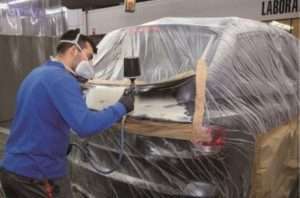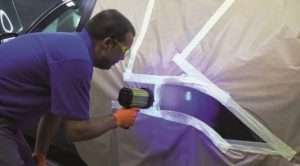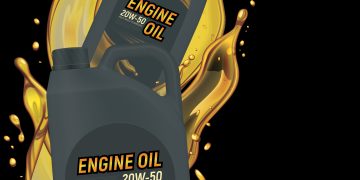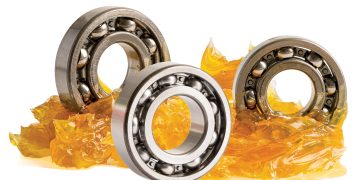Fillers are base or preparation paints used in vehicle repainting with a relevant role in the quality of the final finish and in the productivity of the repainting processes. It is a versatile product, and different types can be found on the market to adapt to different needs in terms of surface leveling, covering, sanding, drying speed, etc. Its main task is to achieve a smooth and uniform surface as a base for the application of the finishing paint.
Tasks
The fillers are one of the preparatory or background paints, along with fillers and primers in vehicle repainting. The tasks fulfilled by the fillers are:
Seal, isolate and prepare the surface for the application of the finishing paint:
The finishing paint must not be applied directly on sheet metal, filler or cataphoresis putty, it must be applied on primers or fillers, or on the old finishing paint that the piece has. Due to its chemical nature and leveling properties, the filler isolates the primer from the topcoat and provides the best base to achieve a high gloss, well stretched topcoat.
Level the surface:
Although its filling capacity is not as high as that of a putty, the filler performs a surface filling function that allows irregularities such as small imperfections and pores that may remain after the application and sanding of the putty or defects such as superficial scratches and sanding marks. It must be borne in mind that the filler should not be applied in excessively loaded coats, as it can lead to drops in gloss or boiling due to the retained solvents.
Facilitate coverage:
The tonality of the filler influences the colour of the final finish obtained in the case of colours with low or medium coverage. In these colours, the application of a filler of a different tonality than that recommended can cause colour matching problems or that a greater number of coloured coats are used, which entails a higher cost in repainting.
Protect against corrosion:
The products known as “Primer–Aparejo” combine the qualities of the fillers with those of the primers, therefore, those of the primers are added to those of the fillers just named: anticorrosive protection (in the case of sheet substrate) and anchor or adhesion promoter.
Classification
The filler is a very versatile and versatile product, and there is a wide range in the refinish market, which can be classified according to different characteristics.
The most commonly used fillers today due to their technical properties and their versatility of use are the so-called “two-component acrylic fillers”, of the same nature as single-coat enamels and finishing varnishes.
Classification according to the coloration of the fillers:
- Conventional fillers: fillers available in a single colour, in neutral colours such as Gray or Beige.
- Tintable or tonable filler: product to which is added a percentage of mixture of basic colours according to the colour to be applied as a finish, achieving a background colour very similar to the base coat or single coat enamel and thus facilitating its coverage.
- Coloured filler: available in a range of colours, White, Black, Red, Green, Blue and Yellow, which are mixed in a certain proportion, according to the finish colour code and manufacturer’s instructions, achieving the most suitable background for the colour of the surface finishing paint.
The main task of the fillers is to achieve a smooth and uniform surface as a base for the application of the finishing paint.
- Grayscale fillers: it is the most common nowadays. It consists of a range of fillers in two shades (very Light Gray and Dark Grey) or in three shades (White, Intermediate Gray and Black or Dark Grey) that are mixed to achieve a specific gray scale, from which the one that match the tone height (light-dark) of the finishing paint to facilitate covering. The paint manufacturer provides information regarding which tone to use depending on the finish colour to be prepared.
- Sandable filler: After application, it is allowed to dry and sanded. The finishing paint spreads well and the gloss achieved is maximum. If surface fill is required, such as a repaired part, this type of filler should be applied.
- Wet-on-wet fillers: usually indicated by the acronym “H/H” or “W/W” (wet on wet). The finish paint is applied to the surface before it has completely dried, when it still retains its biting power, performing a sealing and base function for the application of the finish paint. This process is recommended in the case of new parts, since they do not require surface leveling, in the painting of interior parts and in the painting of industrial vehicles. In addition, some of these fillers’ present direct adhesion on the cataphoresis, not being necessary the previous step of sanding before its application.

According to a specific task or characteristics:
- Primer-surfacer: as indicated above, this product combines the characteristics of the primers (anticorrosive protection and anchoring) with those of the primers (leveling, sealing and surface conditioning), although its filling power is lower than that of the primers high thickness.
Depending on your application and drying process:
- Filler or High Build Fillers: Specifically formulated for greater surface fill capacity.
- Quick-drying fillers: Like quick-drying varnishes, these types of fillers have also been developed that allow them to be sanded after air drying in less than an hour or drying in just 5-10 minutes at 60ºC.
- Sealers or insulators: transparent or translucent fillers (can be tinted) that, in addition to anchoring on the base surface, constitute a good insulator between the paints on which it is applied and those that will later cover it, avoiding rejection reactions and thus allowing repainting on dubious funds. They are usually applied wet on wet, without the need for sanding before finishing paint; and in the case of being used as a transparent adherence promoter, it is applied without the need to previously sand the old paint, being used, above all, in commercial and industrial vehicle personalisation operations in changes of colour or labeling for a faster process.
- Specific fillers for plastics: formulated with some flexibility for painting plastics, usually two-component (2K) and the prior application of the anchoring primer for plastics is not usually necessary.
- Aerosol fillers: one-component, 1K, quick-drying primer-filler that is used for specific applications as a sealer, since it does not perform the surface leveling function. For example, if after sanding the filler or shading the finish paint there is some uncovered putty or sheet metal, this spray is applied as a base for the application of the finish paint. They may be available in different shades of Gray.
- UV drying fillers: with photoinitiators that react from exposure to ultraviolet radiation that activates the chemical reaction or polymerisation process. They are used for quick and small repairs, due to their very short drying time and the limited surface area of UV screens.
- Polyfunctional fillers: some fillers can be used for different purposes, being able to function as a high thickness filler, insulating bottom, filler for plastics or as a wet-on-wet filler depending on their preparation and application process.
There are other classifications, for example, like other paints, according to the type of drying: by evaporation of solvents (1K fillers in aerosol), by chemical reaction (2K fillers) and by reaction to ultraviolet light; or according to the solids content, being the HS (High Solids, High Solids) and UHS (Ultra High Solids, Ultra High Solids) the most used today, displacing those with low and medium solids content (LS and MS).
In colours with low-medium coverage, a tinting filler should be applied, coloured or in the appropriate shade of gray according to the colour code of the finishing paint, to achieve the desired colour and facilitate coverage, using the appropriate amount of colour.
Recommendations for the application of filler
When applying the filler in repainting processes, it is recommended:
Correctly prepare the surface:
As always, before applying any paint, an exhaustive cleaning of the surface must be carried out and, in addition, a prior sanding with the appropriate granulometry must be carried out to guarantee good adhesion, except in some fillers with direct adherence on the cataphoresis. This sanding will depend on both the substrate: putty and contour, sheet metal (steel or aluminum), plastic, cataphoresis, primers or old paint; as well as the type of filler to apply: H/H or sandable, high thickness, spray filler, etc.
Choose the most suitable filler according to the type of repair:
Depending on whether it is a new or repaired piece and the need for a specific characteristic (quick drying, high filling power, application on flexible plastic, sealant, etc.), the filler that best suits our needs will be selected. and will be prepared according to its technical file. The hardener and thinner will be chosen based on the temperature and humidity during its application and drying and the extension of the surface to be primed.
Take into account the tonality of the primer according to the finishing paint:
In colours with low-medium coverage, a dyeable filler should be applied, coloured or in the appropriate shade of Gray according to the colour code of the finishing paint, to achieve the desired colour and facilitate coverage, using the appropriate amount of colour.
Carry out a correct application of the filler:
If an application is required in restricted areas, not to a complete piece, it is recommended to apply a first thin coat as a grip and to a greater extent than the next coat, which will be heavier than the first and more closed, to a lesser extent, so as not to cover with this 2nd coat the powders of the 1st, which after sanding could create problems of absorption or sinking.
Respect the evaporation and drying times:
The manufacturers’ instructions must be followed regarding the minimum and maximum evaporation and drying times, to avoid possible defects such as loss of gloss, shrinkage, shrinkage, boiling or adhesion problems of the finishing paint.

Carry out a correct sanding of the surface:
In the case of sandable fillers, it is recommended to start with rough sanding with P320, and then carry out fine sanding, with P400 granulometry when a single coat finish is to be applied and P500 if it is a double coat, even P600 and up to P800 in problem colours (higher transparency). When the filler has been applied to new pieces or small repairs, the rough sanding of the filler is not necessary and the refining is carried out directly. In addition to correctly sanding the filler, its contour and the rest of the surface on which the finishing paint is to be applied must be sanded and smoothed.
National Business Development Head
Automotive Business, AKEMI Technology



























































